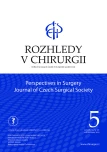Reduction of arteriovenous access blood flow in kidney transplant patients
Authors:
J. Janečková; P. Bachleda; P. Utíkal
Authors‘ workplace:
II. chirurgická klinika Fakultní nemocnice Olomouc
Published in:
Rozhl. Chir., 2022, roč. 101, č. 5, s. 227-231.
Category:
Original articles
doi:
https://doi.org/10.33699/PIS.2022.101.5.227–231
Overview
Introduction: Cardiovascular disease is the most frequent cause of death in kidney transplant patients. High-flow arteriovenous fistula (AVF) increases cardiac output and may contribute to hyperkinetic heart failure. AVF follow-up is not implemented in kidney transplant patients. The aim of this study was to reduce AVF blood flow in a group of patients with a high-flow AVF following kidney transplantation to reduce cardiac strain.
Methods: This prospective study was performed in kidney transplant patients who had a vascular access created before transplantation. The AVF of these patients was examined by ultrasound with a focus on AVF flow and brachial artery size. If high-flow AVF was detected, flow reduction was performed in the indicated group of patients.
Results: The study examined 164 patients, of whom 24 had a hyperfunctional AVF (14.8%). A total of 16 AVF flow reductions were performed, which led to an average decrease in cardiac index by 0.77 L/min/m2. Primary patency of the reconstructions was 93.33% after 12 months. All patients experienced a subjective improvement in dyspnea.
Conclusion: Reduction in AVF flow leads to an improvement in the quality of life of kidney transplant patients. Maintaining a functional AVF is beneficial, especially for patients after repeated surgeries, where the option of creating an autologous AVF is limited.
Keywords:
arteriovenous fistula – blood flow reduction – kidney transplant
Sources
1. Kramer A, Boenink R, Stel VS, et al. The ERA-EDTA Registry Annual Report 2018: a summary. Clin Kidney J. 2021 Feb 3;14(1):107–123. doi:10.1093/ckj/ sfaa271.
2. Boerner B, Shivaswamy V, Desouza C, at al. Diabetes and cardiovascular disease following kidney transplantation. Curr Diabetes Rev. 2011 Jul 1;7(4):221–234. doi:10.2174/157339911796397857.
3. Amerling R, Ronco C, Kuhlman M, et al. Arteriovenous fistula toxicity. Blood Purif. 2011;31(1–3):113–120. https://doi. org/10.1159/000322695.
4. MacRae JM, Pandeya S, Humen DP, et al. Arteriovenous fistula-associated high-output cardiac failure: a review of mechanisms. Am J Kidney Dis. 2004 May;43(5):e21.1−e21.6. doi:10.1053/j. ajkd.2004.01.016.
5. Basile C, Vernaglione L, Casucci F, et al. The impact of haemodialysis arteriovenous fistula on haemodynamic parameters of the cardiovascular system. Clin Kidney J. 2016 Oct;9(5):729–734. doi:10.1177/11297298211059326.
6. Janeckova J, Bachleda P, Koleckova M, et al. Brachial artery aneurysm as a late complication of arteriovenous fistula. J Vasc Access. 2021 Nov 17;112972982110593.
7. Vanderweckene P, Weekers L, Lancellotti P, et al. Controversies in the management of the haemodialysis-related arteriovenous fistula following kidney transplantation. Clin Kidney J. 2018 Jun 1;11(3):406–412. doi:10.1093/ckj/sfx113.
8. Manca O, Pisano GL, Carta P, et al. The management of hemodialysis arteriovenous fistulas in well functioning renal transplanted patients: Many doubts, few certainties. J Vasc Access. 2005 Oct 15;6(4):182–186. doi:10.1177/112972980500600405.
9. Aitken E, Kingsmore D. The fate of the fistula following renal transplantation. Transpl Int. 2014 Sep;27(9):e90–91. doi:10.1111/tri.12326.
10. Balaz P, Rokosny S, Klein D, et al. Aneurysmorrhaphy is an easy technique for arteriovenous fistula salvage. J Vasc Access. 2008 Apr 13;9(2):81–4.
11. Baláž P, Rokošný S, Bafrnec J, et al. Repair of aneurysmal arteriovenous fistulae: A systematic review and meta- analysis. Eur J Vasc Endovasc Surg. 2020 Apr;59(4):614–623. doi:10.1016/j. ejvs.2019.07.033.
12. Rokošný S, Baláž P, Wohlfahrt P, et al. Reinforced aneurysmorrhaphy for true aneurysmal haemodialysis vascular access. Eur J Vasc Endovasc Surg. 2014 Apr;47(4):444–450. doi:10.1016/j. ejvs.2014.01.010.
13. Basile C, Lomonte C, Vernaglione L, et al. The relationship between the flow of arteriovenous fistula and cardiac output in haemodialysis patients. Nephrol Dial Transplant. 2007 Aug 17;23(1):282–287. doi:10.1093/ndt/gfm549.
14. Kanno T, Kamijo Y, Hashimoto K, et al. Outcomes of blood flow suppression methods of treating high flow access in hemodialysis patients with arteriovenous fistula. J Vasc Access. 2015 Nov 9;16(10_suppl):S28–33. doi:10.5301/ jva.5000415.
15. Valerianova A, Malik J, Janeckova J, et al. Reduction of arteriovenous access blood flow leads to biventricular unloading in haemodialysis patients. Int J Cardiol. 2021 Jul 1;334:148−153. doi:10.1016/j.ijcard. 2021.04.027. Epub 2021 Apr 30.
16. Agarwal R. Prevalence, determinants and prognosis of pulmonary hypertension among hemodialysis patients. Nephrol Dial Transplant. 2012 Oct 1;27(10):3908– 3914. doi:10.1093/ndt/gfr661.
17. Malik J, Valerianova A, Tuka V, et al. The effect of high‐flow arteriovenous fistulas on systemic haemodynamics and brain oxygenation. ESC Heart Fail. 2021 Jun;8(3):2165−2171. doi:10.1002/ ehf2.13305.
18. Gkotsis G, Jennings WC, Malik J, et al. Treatment of high flow arteriovenous fistulas after successful renal transplant using a simple precision banding technique. Ann Vasc Surg. 2016 Feb;31:85–90. doi:10.1016/j.avsg.2015.08.012.
Labels
Surgery Orthopaedics Trauma surgeryArticle was published in
Perspectives in Surgery

2022 Issue 5
Most read in this issue
- Pectoralis major ruptures
- Endovenous ablation of varicose veins − current status and overview of methods
- Transversus abdominis release in the management of a large, chronic defect of the abdominal wall
- Appendicolith as a cause of late complications after appendectomy – a case report and literature review
